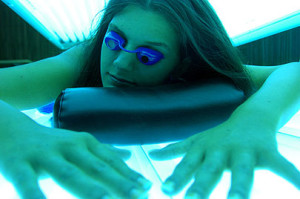I am beyond fair-skinned. The words “pale as a ghost” have been applied to my complexion more than a few times, and not always in a complimentary way. As a teen, I tried just about everything to get that coveted Bay Watch tan. I laid out with baby oil. I tried self-tanners. Yes, I even tried indoor tanning once.
Like most teens, I never thought about the long-term consequences or about the risks to my health from indoor tanning. I just wanted to be pretty. I wish I could go back in time and tell myself a few things about tanning. Here’s what I’d say:
- Young people who start indoor tanning before the age of 35 increase their risk of melanoma by almost 60%.
- More than 400,000 cases of skin cancer, about 6,000 of which are melanomas, are estimated to be related to indoor tanning in the U.S. each year.
- Even one use of a tanning bed increases users’ chances of developing melanoma by 20% and each additional session during the same year boosts the risk almost another 2%.
I didn’t know, but I should have. The science is very clear that indoor tanning causes skin cancer, including melanoma – the most deadly form of skin cancer. More cancer is attributable to indoor tanning than to cigarettes.
Luckily for today’s teens, some smart legislators and organizations – including the N.C. Dermatology Association, the American Cancer Society, and the N.C. Pediatric Society – want to protect young people from these kinds of preventable cancer in North Carolina. They have supported legislation in the last several years to protect teens from the dangers of indoor tanning – and skin cancer – the same way we protect them from alcohol and tobacco.
The “>>tanning bed bill” would ban North Carolinians under 18 from using commercial indoor tanning beds. This same legislation has been approved by 11 other states, including Texas, and was approved by the GOP-controlled North Carolina House in 2013 by an overwhelming vote of 94-22. It also has the backing of the tanning trade group, the >>American Suntanning Association, and national indoor tanning franchise Planet Beach.
There doesn’t seem to be much opposition to it, so hopefully it will pass this session. If pressure from the supporting groups doesn’t get the General Assembly’s attention, maybe the following facts will.
- There is an epidemic of skin cancer among young women – largely the result of indoor tanning. Melanoma is the most common form of cancer for young adults 25-29 years old, and the second most common form of cancer for adolescents and young adults 15-29 years old. >>The stories of melanoma survivors are harrowing.
- Teens are still tanning. According national data from 2013, nearly 1 out of every 3 white high school girls used an indoor tanning device such as a tanning bed, tanning booth, or sun lamp during the last 12 months. There are more than 1,400 tanning beds registered to operate in North Carolina. That is more than twice the number of McDonald’s, more than ten times the number of Starbucks, and more than four times the number of dermatologists in North Carolina.
- In July 2014, the Surgeon General issued >>a call to action on skin cancer, with a major goal being to reduce the harm from indoor tanning. The World Health Organization classified indoor tanning devices as Class I human carcinogens. Last year, the FDA reclassified indoor tanning devices and will require manufacturers to include a warning that people younger than age 18 years should not use these devices.
In hindsight, I am ashamed that I took such serious risks with my health over something so silly as a tan. I wish someone had stopped and shaken me. Heck, I want to talk some sense into all the teen girls who are using tanning beds right now.
This legislation is set to be introduced again in the coming weeks. Here’s hoping that this is the year the N.C. General Assembly gets to work and protects kids from the dangers of indoor tanning. I hope this is the year young women in North Carolina stop risking their health just to be pretty.
>> Sara Lang has worked in North Carolina politics at the state, federal, and local levels for more than 15 years. A communications consultant, she lives in Cary with her husband, two young children, and a pampered dog.
Sara Lang has worked in North Carolina politics at the state, federal, and local levels for more than 15 years. A communications consultant, she lives in Cary with her husband, two young children, and a pampered dog.

There are no comments
Add yours